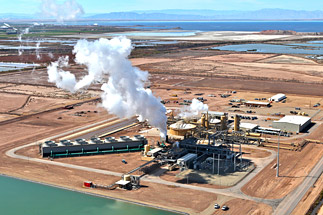Created from rocks deep below the surface of the Earth, geothermal power is perhaps one of the least understood renewable energy sources. But developments are increasingly cropping up across the country as investors realize the both lucrative and green opportunity of the resource.
California-based renewable energy company EnergySource announced recently that newly completed 49.9 MW Hudson Ranch 1 geothermal power plant in Imperial County, California has passed field tests with flying colors and was also successfully connected to the local power grid. The plant is the first geothermal development in the Salton Sea field where Hudson Ranch 1 operates.

Geothermal power is derived from radioactive rocks beneath the surface of the Earth that naturally emit heat. Developers capture the energy by cracking open the rocks and pumping water through them and back up to the surface. The water comes up boiling and the steam rotates a turbine. The Salton Sea field is very hot and very amenable to liquid penetration, but the rocks also contain a high concentration of minerals which makes the drilling and developing more challenging, according to EnergySource. Construction of the project cost an estimated $400 million.
The Hudson Ranch power plant has four injection wells for water to flow through the rocks and three production wells that capture the steam. The wells produce between 15 and 40 MW of power each, making the wells some of the largest geothermal producers in the world. Geothermal power is so abundant in the American west that some have suggested it could even replace the state’s coal, nuclear and natural gas as a source of stable base load power. Indeed, because the rocks are always hot, goethermal power is a renewable energy source that is not intermittent.
But geothermal power also faces the unique challenge, among renewables, of a relatively lengthily construction period. While solar panels can be slapped on a rooftop and wind turbines relatively rapidly constructed and put in place, a geothermal plant can take years to build. Developers need to scout out appropriate locations, like they would for a natural gas or oil well. Once the desired location is chosen, it can take years to find the correct places to drill in the rocks for maximum power and minimal damage.
On top of that, shifting the rocks underground can be extremely dangerous if not done properly, and can cause earthquakes, and a badly drilled well can also allow for excess heat to escape from the rocks. During the time it takes to complete the well, both investors and government tax incentives can fall away, making securing a power purchase agreement from a local utility extremely difficult.
But EnergySource managed to jump through the hoops on its latest development, and has successfully readied the plant for a long life of, hopefully, healthy operation. The power will be bought for 30 years by Salt River Project (SRP), a municipal power and irrigation district in Tempe, Arizona. SRP has in fact already agreed to a second power purchase agreement from EnergySource’s next 49.9 MW geothermal plant, Hudson Ranch II.